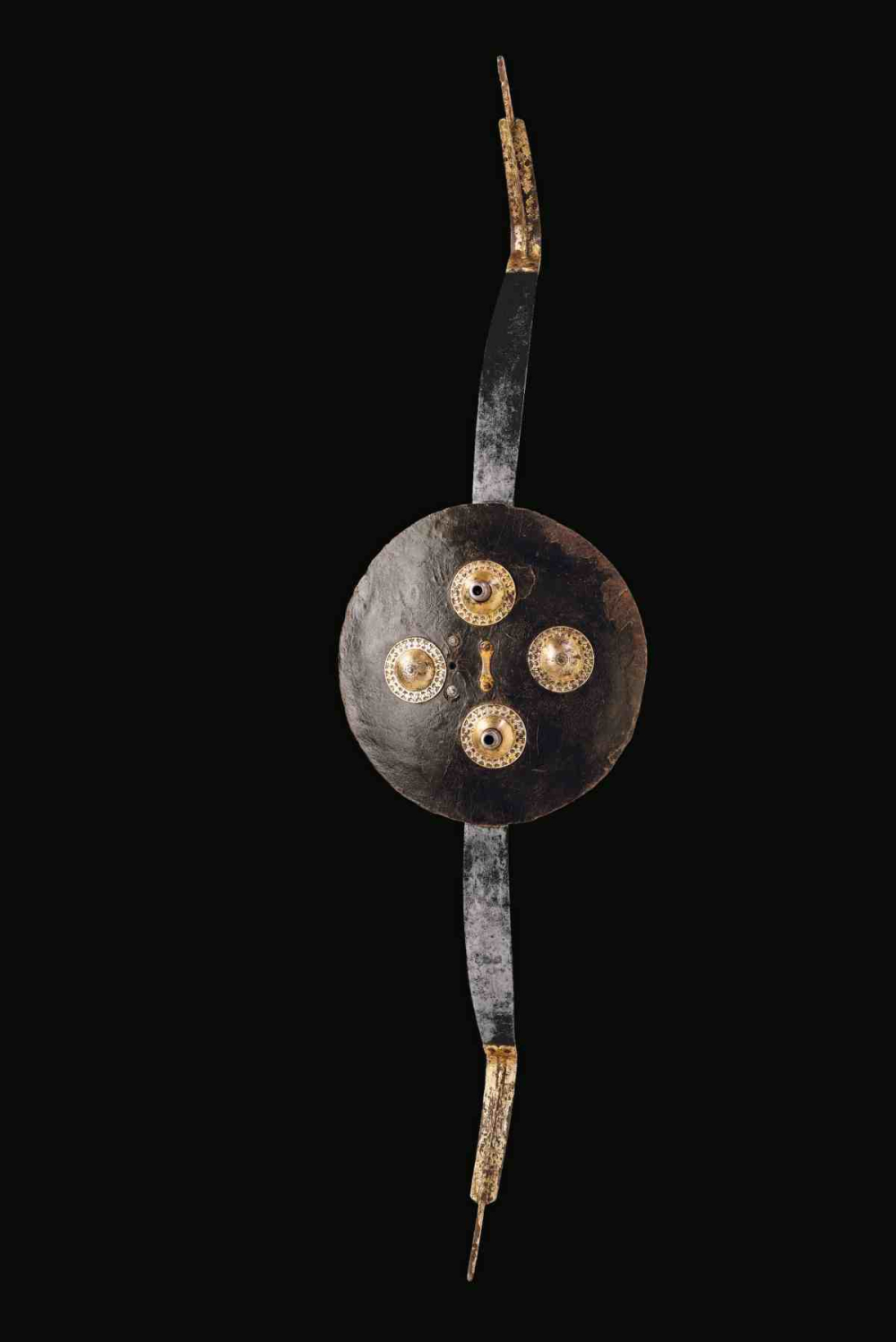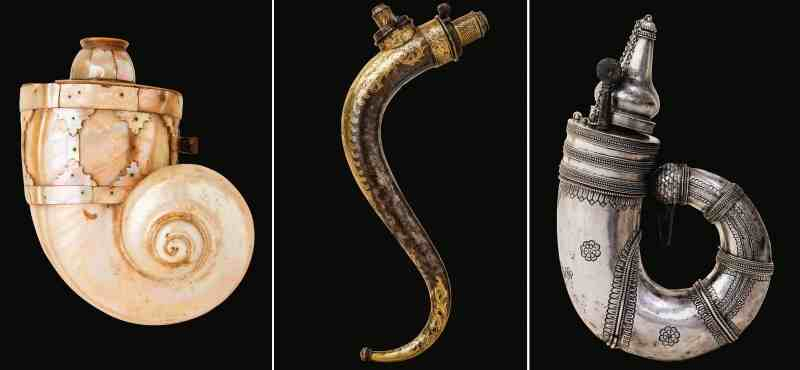A close look at the Rajput warrior’s celebrated weapons, now preserved in museums and forts of the Rajputana states. Sahapedia’s eclectic selection aims to give an interesting insight into not only the various influences on weapon development but also into the world of ceremonial versus functional armoury. (Photo courtesy: National Museum via Google Arts and Culture)
Think of Rajputs, and images of a prestigious warrior culture and splendorous living immediately come to mind. Walk across the many museums in India and the most characteristic objects in the exhibits on Rajputana culture would most likely be amour and armoury (unless, of course, one went into the realm of stunning jewellery).
While these popular associations are quite fitting, what scholars find interesting is that Rajputs themselves were not very experimental in their weaponry—choosing to stick with traditional styles of armoury than adopt more modern technology. Another interesting factor is the marked difference between ceremonial weapons—which include the beautifully ornate swords and shields that are documented in paintings—and weapons that have been used in battle, which might not be as beautiful to look at, but they are lethal.
Also read | African Cavalry Guards: Hyderabadis of Afro-Arab Descent
The fifteenth century saw an increase in centralised rule within the Rajput kingdoms against the diminishing power of the Mughals, leading to greater deployment of militia. A closer look at the Rajput warrior’s celebrated weapons reveals interesting objects that are now preserved in museums and forts of the Rajputana states—like a combination of a pistol with a sword, more for amusement than practical use, or the famous yet unusual case of a renowned king possessing his enemy’s chainmail and even branding it as his own.
The kind of weapons also give an indication of the various influences from other cultures the Rajputs may have interacted with either in the battlefield or due to trade. Alternatively, it could also be a showcase of the finest workmanship in the area, occasionally representing the most important craft of the time. Take this beautifully painted dhal (shield) from Udaipur that is a tribute to the original Rajput sentiment of valour, victory and ceremony.

Of Ceremony and Symbol
Belonging to Maharana Sangram Singh II (1690–1734), this early eighteenth-century shield[1] from Mewar is preserved in the National Museum, New Delhi.
Serving as a symbol of Rajput masculinity, the eight-part landscape in gold highlights paints a story of victory—the king fights, hunts, kills his enemies, and comes back to festivities that show him proudly being welcomed by the queen and atelier. It’s clear from the workmanship, made in one of the many famous workshops in Mewar, that the shield was more ceremonial in nature. It was also a protective marker that allowed safe passage to royal troops, and was displayed in ceremonies to impress the audience with the grandeur and wealth of the owner. Another interesting aspect is that the shield is made of rhinoceros’ skin. While an endangered creature now, historical accounts mention armour of thick rhino skin which suggests that it was quite popular at the time.
Also read | Shivaji’s Ingenious Stratagem: The Pratapgad Fort

Won in Battle
If this shield can be hailed as an example of all things Rajputana, the shirt of mail and plate bearing the name of Maharaja Anup Singh (1669–98) is a significant example of how armour was also won in battle and adopted. As arguably the most celebrated ruler of Bikaner, Anup Singh campaigned in the Deccan and captured substantial number of arms. This piece is now with the Metropolitan Museum of Art, New York.[2]
Also read | How the 1806 Vellore Mutiny Set the Stage for the 1857 Sepoy Mutiny
In contrast to the previous shield, this gorgeous piece of armour has seen many active battles. It’s thought to have come from Bijapur, captured during the sieges of either Golconda or Adoni. What gives it its remarkability is the fact that Anup Singh chose to possess his enemy’s armour for his own, and even inscribe it with his name as testimony to the shirt’s workmanship and functionality.
While taking on another king’s weapon/armour is one thing, combining two cultures of weaponry takes technological experimentation onto a different plane. Take the case of these nineteenth-century combination weapons—bow, shield and percussion pistols all-in-one.

Weapons as Conversation Starters
Nineteenth-century Rajputana saw several experiments in combination weapons. A pistol combined with a bow or sword made for an excellent show of workmanship and ingenuity, however such weapons were quite useless in battle. An example is the piece made for a Raja of Kota (name unknown) in the second half of the century, reportedly manufactured in the royal armoury, now preserved in the Mehrangarh Fort collection.[3]
This multi-weapon consists of a steel bow, a lacquered leather shield, pierced by a steel tube to accommodate an arrow, and a wooden cylindrical grip for support. The pistols are mounted on the back of the shields, each with their own trigger mechanisms.
Similar multi-weapons also include swords with percussion pistols popular with Sikh rulers, often ending up in Marwari Rajput courts. The extraordinary Indian combination weapons ‘never caught on as valuable improvements giving a military advantage, which is the whole point of advancing a weapon’s technology…the walking stick gun is perhaps the only combination weapon that was a success,’ says weapons expert and historian Robert Elgood.

Imports from Foreign Lands
From combining weapon culture to taking inspiration and attempting to replicate it—the gunpowder/priming flask has been commonly found in collections of Rajput weaponry. However, these designer flasks—known as talahiq or hamancha—were imports from Punjab, the Deccan and even the Arabian warriors, from southern Arabia, particularly from Al Mukalla and Ash Shihr in present-day Yemen.[4] Ranging from the eighteenth to the twentieth centuries, these flasks were not only brought from these regions but also eventually manufactured in the weapon capital of Rajputana, Sirohi. Made from Nautilus shell, buffalo horn with wooden core, or blued steel, they hold the uncommon distinction of looking ornate, while being actively used in battle by the Rajputs.

A stunning collection of such flasks can be seen at the Mehrangarh Museum in Jodhpur.[5] Talahiqs are large-sized gunpowder flasks with Arab connections. South Arabian warriors employed by Mughal/Rajput commissioned Indian copies of Arabian weapons and added on to what they brought from home.[6] The traditional horn flasks copy English powder-flasks visible in Rathore paintings of early nineteenth century. Should you see a hole drilled through the underside of such preserved flasks, then that would be the result of an Indian government law requiring all firearms to be deactivate, as these were mistakenly thought to be firearms.[7]
This eclectic selection of weapons and armour found in various Rajput exhibitions across the world is just a tiny tip of the iceberg when it comes to the history of one of India’s most celebrated warriors. It gives an interesting insight into not only the various influences on weapon development but also into the world of ceremonial versus functional armoury.
This content has been created as part of a project partnered with Royal Rajasthan Foundation, the social impact arm of Rajasthan Royals, to document the cultural heritage of the state of Rajasthan.
This article was also published on Scroll.in
Notes
[1] J.D. Hill and Naman Ahuja, India & the World: A History in Nine Stories (New Delhi: Penguin India, 2017), 85.
[2] Peter Dekker, 'The Bikaner Armory', Mandarin Mansion Antiques (November 14, 2017). Accessed March 29, 2021. https://www.mandarinmansion.com/article/bikaner-armory.
[3] Robert Elgood, Rajput Arms & Armour: The Rathores & Their Armoury at Jodhpur Fort, Vol. 1 (Ahmedabad: Mapin Publishing, 2004), 858.
[4] Ibid., 862–65
[5] Ibid.
[6] Ibid.
[7] Ibid.












